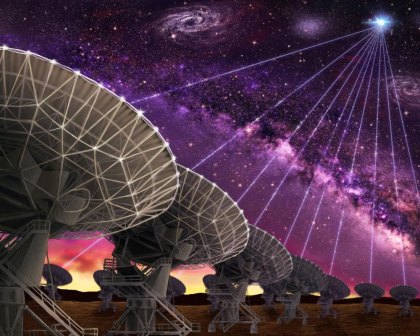Video:
Science in Brief: Source of radio bursts nailed

Scientists were able to determine the source of the burst.
Illustration: Danielle Futselaar
In a new report published in the journal Nature, astronomers confirm that these bursts are “long-distance flashes from across the universe -- more than 3 billion light-years away,” according to a news release from Cornell University. The burst is from the constellation Auriga.
Fast radio bursts were first seen about 10 years ago.
Asked about the cause of the burst, Shami Chatterjee, Cornell senior research associate in astronomy, said, “We think it may be a magnetar -- a newborn neutron star with a huge magnetic field, inside a supernova remnant or a pulsar wind nebula -- somehow producing these prodigious pulses. Or, it may be an active galactic nucleus of a dwarf galaxy. That would be novel. Or, it may be a combination of those two ideas -- explaining why what we’re seeing may be somewhat rare.”
Read the Cornell report here.
ICE RIDGES ON PLUTO: Scientists from York University in Toronto have found evidence of snow and ice ridges on Pluto.
The icy features, called “penitentes” and formed by erosion, are “bowl-shaped depressions with spires around the edge, and are several meters high,” a York University news release explained.
In a university video, John Moores, a professor in the department of Earth and space science and engineering, explained that there is a “place on Pluto where you’ve got the signature of methane ice and it’s different from the ices that are on other parts of the planet, which is mostly nitrogen ice.”
The ice transitions directly from solid form into gas, he added. And the sunlight's interaction forms the sculpting on the surface.
These ice features previously have been seen only on Earth.
Related:
In brief: Extreme outbreaks more common
Pluto may have ocean still in existence
Follow StudyHall.Rocks on Twitter.
If you would like to comment, give us a shout, or like us on Facebook and tell us what you think.

